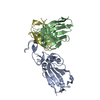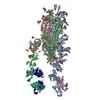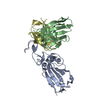[English] 日本語
 Yorodumi
Yorodumi- PDB-8v4f: Model and map from local refinement of a CAB-A17 - Omicron Ba.1 s... -
+ Open data
Open data
- Basic information
Basic information
| Entry | Database: PDB / ID: 8v4f | ||||||
|---|---|---|---|---|---|---|---|
| Title | Model and map from local refinement of a CAB-A17 - Omicron Ba.1 spike complex | ||||||
 Components Components |
| ||||||
 Keywords Keywords | VIRAL PROTEIN/IMMUNE SYSTEM / SARS-CoV-2 / spike / RBD / antibody / Fab / VIRAL PROTEIN / VIRAL PROTEIN-IMMUNE SYSTEM complex | ||||||
| Function / homology |  Function and homology information Function and homology informationsymbiont-mediated disruption of host tissue / Maturation of spike protein / Translation of Structural Proteins / Virion Assembly and Release / host cell surface / host extracellular space / viral translation / symbiont-mediated-mediated suppression of host tetherin activity / Induction of Cell-Cell Fusion / structural constituent of virion ...symbiont-mediated disruption of host tissue / Maturation of spike protein / Translation of Structural Proteins / Virion Assembly and Release / host cell surface / host extracellular space / viral translation / symbiont-mediated-mediated suppression of host tetherin activity / Induction of Cell-Cell Fusion / structural constituent of virion / membrane fusion / entry receptor-mediated virion attachment to host cell / Attachment and Entry / host cell endoplasmic reticulum-Golgi intermediate compartment membrane / positive regulation of viral entry into host cell / receptor-mediated virion attachment to host cell / host cell surface receptor binding / symbiont-mediated suppression of host innate immune response / receptor ligand activity / endocytosis involved in viral entry into host cell / fusion of virus membrane with host plasma membrane / fusion of virus membrane with host endosome membrane / viral envelope / symbiont entry into host cell / virion attachment to host cell / SARS-CoV-2 activates/modulates innate and adaptive immune responses / host cell plasma membrane / virion membrane / identical protein binding / membrane / plasma membrane Similarity search - Function | ||||||
| Biological species |  Homo sapiens (human) Homo sapiens (human) | ||||||
| Method | ELECTRON MICROSCOPY / single particle reconstruction / cryo EM / Resolution: 2.68 Å | ||||||
 Authors Authors | Hallberg, B.M. / Das, H. | ||||||
| Funding support |  Sweden, 1items Sweden, 1items
| ||||||
 Citation Citation |  Journal: Cell Rep Med / Year: 2024 Journal: Cell Rep Med / Year: 2024Title: Structural basis of broad SARS-CoV-2 cross-neutralization by affinity-matured public antibodies. Authors: Daniel J Sheward / Pradeepa Pushparaj / Hrishikesh Das / Allison J Greaney / Changil Kim / Sungyong Kim / Leo Hanke / Erik Hyllner / Robert Dyrdak / Jimin Lee / Xaquin Castro Dopico / Pia ...Authors: Daniel J Sheward / Pradeepa Pushparaj / Hrishikesh Das / Allison J Greaney / Changil Kim / Sungyong Kim / Leo Hanke / Erik Hyllner / Robert Dyrdak / Jimin Lee / Xaquin Castro Dopico / Pia Dosenovic / Thomas P Peacock / Gerald M McInerney / Jan Albert / Martin Corcoran / Jesse D Bloom / Ben Murrell / Gunilla B Karlsson Hedestam / B Martin Hällberg /      Abstract: Descendants of the severe acute respiratory syndrome coronavirus 2 (SARS-CoV-2) Omicron variant now account for almost all SARS-CoV-2 infections. The Omicron variant and its sublineages have spike ...Descendants of the severe acute respiratory syndrome coronavirus 2 (SARS-CoV-2) Omicron variant now account for almost all SARS-CoV-2 infections. The Omicron variant and its sublineages have spike glycoproteins that are highly diverged from the pandemic founder and first-generation vaccine strain, resulting in significant evasion from monoclonal antibody therapeutics and vaccines. Understanding how commonly elicited antibodies can broaden to cross-neutralize escape variants is crucial. We isolate IGHV3-53, using "public" monoclonal antibodies (mAbs) from an individual 7 months post infection with the ancestral virus and identify antibodies that exhibit potent and broad cross-neutralization, extending to the BA.1, BA.2, and BA.4/BA.5 sublineages of Omicron. Deep mutational scanning reveals these mAbs' high resistance to viral escape. Structural analysis via cryoelectron microscopy of a representative broadly neutralizing antibody, CAB-A17, in complex with the Omicron BA.1 spike highlights the structural underpinnings of this broad neutralization. By reintroducing somatic hypermutations into a germline-reverted CAB-A17, we delineate the role of affinity maturation in the development of cross-neutralization by a public class of antibodies. | ||||||
| History |
|
- Structure visualization
Structure visualization
| Structure viewer | Molecule:  Molmil Molmil Jmol/JSmol Jmol/JSmol |
|---|
- Downloads & links
Downloads & links
- Download
Download
| PDBx/mmCIF format |  8v4f.cif.gz 8v4f.cif.gz | 92.2 KB | Display |  PDBx/mmCIF format PDBx/mmCIF format |
|---|---|---|---|---|
| PDB format |  pdb8v4f.ent.gz pdb8v4f.ent.gz | 68.9 KB | Display |  PDB format PDB format |
| PDBx/mmJSON format |  8v4f.json.gz 8v4f.json.gz | Tree view |  PDBx/mmJSON format PDBx/mmJSON format | |
| Others |  Other downloads Other downloads |
-Validation report
| Summary document |  8v4f_validation.pdf.gz 8v4f_validation.pdf.gz | 1 MB | Display |  wwPDB validaton report wwPDB validaton report |
|---|---|---|---|---|
| Full document |  8v4f_full_validation.pdf.gz 8v4f_full_validation.pdf.gz | 1 MB | Display | |
| Data in XML |  8v4f_validation.xml.gz 8v4f_validation.xml.gz | 35.7 KB | Display | |
| Data in CIF |  8v4f_validation.cif.gz 8v4f_validation.cif.gz | 50.8 KB | Display | |
| Arichive directory |  https://data.pdbj.org/pub/pdb/validation_reports/v4/8v4f https://data.pdbj.org/pub/pdb/validation_reports/v4/8v4f ftp://data.pdbj.org/pub/pdb/validation_reports/v4/8v4f ftp://data.pdbj.org/pub/pdb/validation_reports/v4/8v4f | HTTPS FTP |
-Related structure data
| Related structure data |  42970MC  8c0yC  8c2rC M: map data used to model this data C: citing same article ( |
|---|---|
| Similar structure data | Similarity search - Function & homology  F&H Search F&H Search |
- Links
Links
- Assembly
Assembly
| Deposited unit | 
|
|---|---|
| 1 |
|
- Components
Components
| #1: Antibody | Mass: 12926.275 Da / Num. of mol.: 1 Source method: isolated from a genetically manipulated source Source: (gene. exp.)  Homo sapiens (human) / Cell line (production host): HEK293 / Production host: Homo sapiens (human) / Cell line (production host): HEK293 / Production host:  Homo sapiens (human) Homo sapiens (human) |
|---|---|
| #2: Antibody | Mass: 11395.632 Da / Num. of mol.: 1 Source method: isolated from a genetically manipulated source Source: (gene. exp.)  Homo sapiens (human) / Production host: Homo sapiens (human) / Production host:  Homo sapiens (human) Homo sapiens (human) |
| #3: Protein | Mass: 21968.818 Da / Num. of mol.: 1 / Fragment: Omicron BA.1 RBD Source method: isolated from a genetically manipulated source Details: RBD of Omicron BA.1 spike Source: (gene. exp.)  Gene: S, 2 / Variant: BA.1 / Cell line (production host): HEK293 / Production host:  Homo sapiens (human) / References: UniProt: P0DTC2 Homo sapiens (human) / References: UniProt: P0DTC2 |
| Has protein modification | Y |
-Experimental details
-Experiment
| Experiment | Method: ELECTRON MICROSCOPY |
|---|---|
| EM experiment | Aggregation state: PARTICLE / 3D reconstruction method: single particle reconstruction |
- Sample preparation
Sample preparation
| Component | Name: Complex between Fab preparation of CAB-A17 and Omicron Ba.1 spike Type: COMPLEX / Entity ID: all / Source: RECOMBINANT |
|---|---|
| Molecular weight | Experimental value: NO |
| Source (natural) | Organism:  Homo sapiens (human) Homo sapiens (human) |
| Source (recombinant) | Organism:  Homo sapiens (human) Homo sapiens (human) |
| Buffer solution | pH: 7.4 |
| Specimen | Embedding applied: NO / Shadowing applied: NO / Staining applied: NO / Vitrification applied: YES |
| Vitrification | Cryogen name: ETHANE |
- Electron microscopy imaging
Electron microscopy imaging
| Experimental equipment |  Model: Titan Krios / Image courtesy: FEI Company |
|---|---|
| Microscopy | Model: TFS KRIOS |
| Electron gun | Electron source:  FIELD EMISSION GUN / Accelerating voltage: 300 kV / Illumination mode: FLOOD BEAM FIELD EMISSION GUN / Accelerating voltage: 300 kV / Illumination mode: FLOOD BEAM |
| Electron lens | Mode: BRIGHT FIELD / Nominal defocus max: 1500 nm / Nominal defocus min: 300 nm |
| Image recording | Electron dose: 54.6 e/Å2 / Film or detector model: GATAN K3 BIOQUANTUM (6k x 4k) Details: Collected at the Karolinska Institutet's 3D-EM facility |
- Processing
Processing
| CTF correction | Type: PHASE FLIPPING AND AMPLITUDE CORRECTION |
|---|---|
| 3D reconstruction | Resolution: 2.68 Å / Resolution method: FSC 0.143 CUT-OFF / Num. of particles: 199751 / Symmetry type: POINT |
 Movie
Movie Controller
Controller




 PDBj
PDBj




